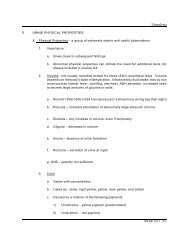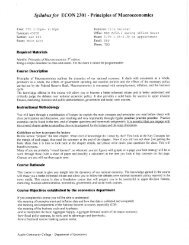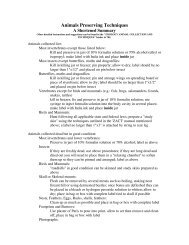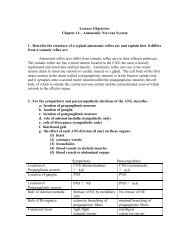Viruses, Viroids & Prions Viruses
Viruses, Viroids & Prions Viruses
Viruses, Viroids & Prions Viruses
You also want an ePaper? Increase the reach of your titles
YUMPU automatically turns print PDFs into web optimized ePapers that Google loves.
<strong>Viruses</strong>, <strong>Viroids</strong> & <strong>Prions</strong><br />
nonliving “infectious agents” capable of causing<br />
diseases<br />
too small to see with regular microscope<br />
even though they are not alive; we still use the<br />
terminology of biology to describe them and how<br />
they work<br />
<strong>Viruses</strong><br />
viruses are not alive (remember characteristics of<br />
life) they do not consist of cells<br />
they do not contain both DNA and RNA<br />
many completely lack DNA<br />
they do not grow<br />
they do not take in nutrients or release waste products<br />
viruses are strict parasites<br />
infect virtually every form of life, every kingdom<br />
History of Study of <strong>Viruses</strong>:<br />
remained part of the invisible world until late 1800’s<br />
1880’s: Pasteur knew that rabies was caused by something<br />
smaller than bacteria<br />
1890’s: viruses were first isolated<br />
1930’s: viruses crystallized;<br />
Microbiology & Diseasse: <strong>Viruses</strong>, <strong>Prions</strong> & <strong>Viroids</strong>; Ziser Lecture Notes 2009 1
life doesn’t crystallize, cannot be living organisms<br />
1940’s: viruses first seen in with newly invented electron<br />
microscope<br />
most of our knowledge of viruses has come in the last 50 years<br />
Viral Structure<br />
size: millions could fit on head of pin<br />
20 – 14000 nm (0.2 – 14 µm)<br />
bacteria are 1000’s - 10’s of 1000’s of times larger<br />
(1-10µm)<br />
all viruses are made of at least 2 parts;<br />
1. an inner core of nucleic acid<br />
2. enclosed in protein capsid<br />
3. some also contain lipoprotein envelope<br />
1. Nucleic Acid<br />
viruses contain a single kind of nucleic acid<br />
can be circular, liner or in several separate segments<br />
genome can be DNA or RNA, never both<br />
only a few genes:<br />
Microbiology & Diseasse: <strong>Viruses</strong>, <strong>Prions</strong> & <strong>Viroids</strong>; Ziser Lecture Notes 2009 2
viruses don’t need lots of genes like living cells<br />
they use the genes, synthesis machinery and<br />
enzymes of host cells to reproduce<br />
most viruses have 6-10 genes<br />
smallest have 4, largest have 100’s of genes<br />
eg. smallpox has 200-300 genes<br />
(but bacteria, eg. E. coli 16 time more)<br />
includes few 1000 to 250,000 pairs of nucleotides<br />
(E. coli 4M pairs of nucleotides)<br />
2. capsid or protein shell surrounds the nucleic acid<br />
makes up most of the mass of the virus particles<br />
many different shapes of capsids<br />
3. some covered with viral envelope<br />
derived from membrane of host cell<br />
Typical Virus “Life Cycle”:<br />
1. attachment<br />
onto specific host cell<br />
its what makes them host specific<br />
2. penetration<br />
Microbiology & Diseasse: <strong>Viruses</strong>, <strong>Prions</strong> & <strong>Viroids</strong>; Ziser Lecture Notes 2009 3
either by<br />
1. injection of nucleic acid<br />
injection can by hypodermic like<br />
2. enzymes may dissolve a hole in cell<br />
membrane of host<br />
3. entire virus particle gets taken in by<br />
phagocytosis triggered by virus<br />
3. Synthesis of new virus particles<br />
once inside, host protein synthesis is stopped<br />
then virus has host make proteins to:<br />
seal cell puncture wound<br />
copy viral genome<br />
make capsid proteins<br />
produce enzmes for lysis of host<br />
enzymes needed for protein synthesis, ribosomes,<br />
energy production are supplied by host cell<br />
4. Lysis<br />
release of virus and death of host cell<br />
a single virus can give rise to up to 1000 new virus<br />
particles from one host cell<br />
(average = 50-200)<br />
Microbiology & Diseasse: <strong>Viruses</strong>, <strong>Prions</strong> & <strong>Viroids</strong>; Ziser Lecture Notes 2009 4
duration of viral life cycle in host cell averages 20-40<br />
minutes<br />
polio: 6-8hrs<br />
herpes: 12-30min<br />
some viruses remain dormant for a time in host cell<br />
and become part of the hosts genome temporarily<br />
Pathogenicity of <strong>Viruses</strong><br />
pathogenicity = how easily disease is spread<br />
most viruses are easily spread<br />
most common means of transfer is by contact with<br />
secretions from infected person<br />
eg. Colds & Flu<br />
when you cough you can deposit up to 1M viruses in your<br />
hand<br />
one person can leave 1000’s of viral particles behind by<br />
touching things<br />
takes as few as 10 particles to infect average person<br />
cold viruses can survive up to 72 hrs on glass, steel and<br />
formica surfaces<br />
susceptibility to any microbial disease depends in part<br />
on its infectious dose (ID)<br />
= the number of particles required to be likely<br />
Microbiology & Diseasse: <strong>Viruses</strong>, <strong>Prions</strong> & <strong>Viroids</strong>; Ziser Lecture Notes 2009 5
to cause an infection<br />
if only a few they may be overcome by a persons<br />
defense system<br />
humans tend to be susceptible to a lower ID for<br />
viruses than for most other kinds of pathogens<br />
Virulence<br />
eg. infectious hepatitis (hep A) ~10-100<br />
eg. rabies ~10 virus particles<br />
eg. polio ~2<br />
eg. measles ~1<br />
virulence = how bad the disease actually is; how<br />
much damage it causes<br />
symptoms of viral diseases range from very mild<br />
(asymptomatic) to lethal<br />
acute to chronic infections<br />
many are childhood diseases,<br />
some self limiting<br />
others remain a lifetime<br />
Microbiology & Diseasse: <strong>Viruses</strong>, <strong>Prions</strong> & <strong>Viroids</strong>; Ziser Lecture Notes 2009 6
Examples of <strong>Viruses</strong><br />
1. viral diseases<br />
eg rabies, cold, flu, HIV<br />
Microbiology & Diseasse: <strong>Viruses</strong>, <strong>Prions</strong> & <strong>Viroids</strong>; Ziser Lecture Notes 2009 7
eg. Rabies<br />
Examples of viral Diseases:<br />
animal disease = zoonosis<br />
worldwide most commonly passed to humans by dog<br />
bites; in US mainly by wild animals<br />
in nature rabies is a viral disease of carnivores<br />
skunks, foxes, raccoons, bats, coyotes<br />
also infects other domesticated animals:<br />
cats, cattle, sheep<br />
transmission to humans is rare and almost always fatal<br />
if not treated<br />
100’s/yr in US infected<br />
usually transmitted by bite or lick from infected animal<br />
virus particles are in saliva<br />
~80% from bites of wild animals<br />
~20% from bites of domestic animals<br />
might also be transmitted by aerosols and enter the<br />
lungs<br />
eg. in bat caves<br />
long incubation time (1-1.5 months) before symptoms<br />
appear<br />
Microbiology & Diseasse: <strong>Viruses</strong>, <strong>Prions</strong> & <strong>Viroids</strong>; Ziser Lecture Notes 2009 8
can be vaccinated after exposure if in the<br />
first week or so<br />
vaccines are typically given BEFORE exposure<br />
initially the virus multiplies in skeletal muscle and<br />
connective tissues<br />
remains localized for days or months<br />
then it enters peripheral nerves and travels along<br />
nerves to CNS (can take up to 3 months)<br />
once it enters the CNS it is no longer accessible to the<br />
immune system<br />
there causes encephalitis and painful death<br />
if the original bite is in an area rich in nerve fibers (eg.<br />
hands or face) the incubation period is shorter<br />
Symptoms:<br />
Initial: mild then muscle spasms esp in face and neck<br />
Once it gets in CNS:<br />
agitation vs calm periods<br />
spasms of mouth and throat muscles esp when swallowing<br />
painful throat spasms & convulsive choking<br />
causes fear of swallowing=hydrophobia<br />
Microbiology & Diseasse: <strong>Viruses</strong>, <strong>Prions</strong> & <strong>Viroids</strong>; Ziser Lecture Notes 2009 9
End Stage: extensive brain & spinal cord damage, delerium,<br />
renal failure, coma<br />
death usually occurs within 6 days of onset of final<br />
symptoms<br />
Microbiology & Diseasse: <strong>Viruses</strong>, <strong>Prions</strong> & <strong>Viroids</strong>; Ziser Lecture Notes 2009 10
eg. Herpes simplex<br />
large group of viruses<br />
relative of chicken pox and Epstein Barr viruses<br />
herpes simplex: fever blisters & genital infections<br />
herpes zoster: chickenpox & shingles<br />
cytomegalovirus; infects internal organs<br />
Epstein-Barr virus: lymphatic tissue<br />
tendency to produce creeping rash<br />
some have tendency for oncogenesis<br />
humans are only host<br />
requires direct contact to spread<br />
very high infection rate<br />
90% infected in US<br />
initial infection often goes unnoticed<br />
~15% develop lesions<br />
once infected 20-50% of cases virus enters nerves<br />
latent virus persists in nerves<br />
lifetime infection = chronic<br />
recurrence triggered by stress:<br />
Microbiology & Diseasse: <strong>Viruses</strong>, <strong>Prions</strong> & <strong>Viroids</strong>; Ziser Lecture Notes 2009 11
fever, menstruation, injury, colds, etc<br />
recurrent infection usually less severe than initial<br />
outbreaks become less frequent with age<br />
two major forms cold sores (type I) and genital<br />
herpes (type II)<br />
both can occur in either area<br />
HSV-1 (type I) - cold sores<br />
usually in skin, eyes, mucous membranes, nervous system<br />
alternate with latency when virus “hides” in nerves<br />
symptoms often exhibit during stress,<br />
less frequent with age<br />
Herpes gladiatorum<br />
esp head and neck<br />
3% incidence in HS wrestlers<br />
HSV-2 (type I) - genital herpes<br />
sexually transmitted; esp 14-29 yr olds<br />
more severe form of virus: can cause painful urination<br />
one of top 5 STD’s 5 M cases total 300,000/yr<br />
condoms not particularly effective<br />
especially dangerous for pregnant women<br />
fetus can be infected before birth<br />
Microbiology & Diseasse: <strong>Viruses</strong>, <strong>Prions</strong> & <strong>Viroids</strong>; Ziser Lecture Notes 2009 12
virus can cross placenta<br />
often lethal<br />
newborns can be infected during birth esp if active lesions<br />
are present<br />
caesarian may be required<br />
severe or fatal in patients with immunologic deficiencies<br />
no good treatment; no vaccine yet<br />
Microbiology & Diseasse: <strong>Viruses</strong>, <strong>Prions</strong> & <strong>Viroids</strong>; Ziser Lecture Notes 2009 13
eg. HIV/AIDS<br />
second most lethal infectious disease in the world:<br />
~10’s of millions are infected,3 Million die each<br />
year worldwide (2008)<br />
first recognized in US in 1981<br />
today (2005) 1 M in US have the disease<br />
many are people who do not know they are<br />
infected<br />
originated in central Africa<br />
similar virus infects green monkeys in central Africa<br />
harmless infection for monkeys<br />
probably mutated from common primate virus<br />
Infection requires direct contact with body fluids;<br />
sexually transmitted, needles, mothers milk,<br />
organ transplants<br />
only slight risk today from blood transfusions; was once a major<br />
source of infections<br />
most dangerous sexual contact is anal intercourse<br />
vaginal intercourse woman more at risk than male<br />
rare oral genital contact<br />
Microbiology & Diseasse: <strong>Viruses</strong>, <strong>Prions</strong> & <strong>Viroids</strong>; Ziser Lecture Notes 2009 14
30% of children born to HIV+ mothers are infected<br />
one possible case of spread by saliva<br />
Can’t get it from kissing, touching, sharing<br />
utensils, etc<br />
HIV particles in body fluids of infected person:<br />
Blood 10-1000 inf particles/ml<br />
Semen 10-50 IP/ml<br />
Saliva
can spread directly from cell to cell without entering<br />
the blood where it would be more easily detected<br />
Symptoms<br />
begins with sudden flu-like symptoms<br />
few weeks may produce fever, fatigue, swollen<br />
glands, some get rash<br />
but most show no symptoms at all<br />
for several years the only indication of its presence<br />
may be swollen glands<br />
virus hides in lymph nodes<br />
progression of the disease depends on:<br />
how much virus a person is exposed to<br />
condition of patient<br />
Incubation period lasts years before AIDS<br />
symptoms appear<br />
typical incubation period is ~10 yrs<br />
eventually HIV infections are so widespread that they<br />
begin to produce recognizable symptoms: AIDS<br />
night sweats<br />
malaise<br />
nausea<br />
headaches<br />
Microbiology & Diseasse: <strong>Viruses</strong>, <strong>Prions</strong> & <strong>Viroids</strong>; Ziser Lecture Notes 2009 16
symptoms may persist for years<br />
Its virulence is due to the fact that it infects the T-cells of the immune<br />
system<br />
these are the cells that control the entire system<br />
if they are knocked out the immune system fails<br />
eventually, immune system is inactivated<br />
opportunistic infections and cancers ravage the<br />
body<br />
HIV reproduces and mutates so fast that body cannot<br />
produce antibodies to fight it<br />
few actually die of HIV<br />
they die of pneumonia, cancer, TB, hepatitis, etc<br />
in past couple of years incidence and death rate<br />
has decreased dramatically in US with intensive<br />
treatment regimes<br />
but still a very deadly disease in the rest of the<br />
world<br />
Microbiology & Diseasse: <strong>Viruses</strong>, <strong>Prions</strong> & <strong>Viroids</strong>; Ziser Lecture Notes 2009 17
2. Some viruses cause cancer<br />
~100’s different kinds of cancer<br />
numerous causes: genetic, chemicals, viruses<br />
viral causes – not contageous<br />
eg. Epstein Barr virus: mononucleosus lymphatic cancer<br />
90% of US carry latent stage of this virus in WBC’s<br />
with no signs of disease<br />
eg. Hepatitis B virus implicated in liver cancers<br />
eg. HTLV 1&2 leukemia<br />
Microbiology & Diseasse: <strong>Viruses</strong>, <strong>Prions</strong> & <strong>Viroids</strong>; Ziser Lecture Notes 2009 18
Viral Applications<br />
1. Genetic Engineering<br />
viruses are sometimes used as vectors in genetic<br />
engineering research to transmit a specific<br />
gene to engineered cells<br />
eg. cystic fibrosis<br />
eg. plants – tobacco mosaic virus<br />
2. Bacteriophages (bacteria viruses)<br />
are being looked at as a way to treat some<br />
bacterial infections without the use of<br />
antibiotics, to which many bacterial are<br />
becoming resistant.<br />
3. using viruses to protect food products<br />
(2006) FDA approved a 6 virus coctail to be<br />
sprayed onto ready to eat meats<br />
protects against Listeria which causes 2500 cases<br />
of severe food poisoning and 500 deaths<br />
annually in US<br />
4. using viruses to treat cancer<br />
when healthy cells are infected by a virus they<br />
commit suicide<br />
Microbiology & Diseasse: <strong>Viruses</strong>, <strong>Prions</strong> & <strong>Viroids</strong>; Ziser Lecture Notes 2009 19
ideal tool to kill cancer cells<br />
mutated herpes virus that can only multiply in<br />
tumor cells<br />
still only experimental<br />
5. as biological controls of insect pests<br />
over 300 viruses have been discovered with<br />
biological control potential against insect pests<br />
Microbiology & Diseasse: <strong>Viruses</strong>, <strong>Prions</strong> & <strong>Viroids</strong>; Ziser Lecture Notes 2009 20
<strong>Viroids</strong><br />
even viruses are not the smallest infectious particles<br />
around.<br />
viroids naked RNA molecules<br />
no capsid<br />
no coatings = disease<br />
causing<br />
prions pieces of proteins molecules<br />
no nucleic acids involved<br />
<strong>Viroids</strong><br />
viroids have 0.1 th the genetic material of the smallest<br />
virus (350 bases)<br />
if bases were 1mm wide:<br />
human sperm 1800 miles<br />
T2 virus 2 football fields<br />
viroids 1 foot long<br />
too small to encode for even a single enzyme<br />
don’t know how they cause disease<br />
about a dozen known viroids<br />
so far only infect plants:<br />
tomatoes, potatoes, cucumbers, citrus trees,<br />
chrysanthemums<br />
Microbiology & Diseasse: <strong>Viruses</strong>, <strong>Prions</strong> & <strong>Viroids</strong>; Ziser Lecture Notes 2009 21
eg. killed 12 million coconut trees in Phillipines<br />
eg. in 50’s killed most of the chrysanthemums in US<br />
no one has been able to isolate an animal viroid<br />
but they may be involved in animal diseases like:<br />
arthritis<br />
encephalopathies<br />
cancerous lymphomas<br />
Microbiology & Diseasse: <strong>Viruses</strong>, <strong>Prions</strong> & <strong>Viroids</strong>; Ziser Lecture Notes 2009 22
<strong>Prions</strong><br />
an infectious agent that can replicate without genetic<br />
material<br />
also called “slow viruses”<br />
not really virus protein fragments<br />
seem to be mutated proteins from “hosts” own brain<br />
cells that are able to be passed from host to host<br />
the “normal” proteins play vital roles in brain<br />
function and memory<br />
at least one genetic disease seems to be due to a<br />
similar kind of mutation<br />
eg. a genetic disease in a few families<br />
when they reach middle age they can no longer sleep<br />
die in a few weeks from exhaustion<br />
prions are similar kinds of mutated proteins that can<br />
be transmitted from one host to another<br />
prions cause 8 known animal diseases<br />
long term infections; but typically fatal<br />
all 8 are neurological diseases:<br />
Microbiology & Diseasse: <strong>Viruses</strong>, <strong>Prions</strong> & <strong>Viroids</strong>; Ziser Lecture Notes 2009 23
cause mental derangement<br />
loss of muscle control<br />
progressive and fatal<br />
eg. kuru<br />
New Guinea – eat brain to spread disease<br />
eg. Creutzfeldt-Jakob disease (= Mad Cow<br />
Disease)<br />
spread cow to cow in animal feed that contains ground<br />
brains from infected animals<br />
spread to humans in infected meat (hamburger)<br />
eg. scrapie<br />
in sheep<br />
some evidence prions may be involved in:<br />
Parkinsons disease<br />
progressive loss of motor function<br />
begins in 50’s or 60’s<br />
can be hereditary<br />
due to degeneration of dopamine releasing neurons in<br />
substantia nigra (inhibitory neurons)<br />
leads to hyperactivity of basal nuclei and involuntary muscle<br />
contractions<br />
results in shaking hands, facial muscles become rigid, range<br />
of motion decreases<br />
develops smaller steps, slow shuffling gait with forward bent<br />
posture and a tendency to fall forward<br />
Microbiology & Diseasse: <strong>Viruses</strong>, <strong>Prions</strong> & <strong>Viroids</strong>; Ziser Lecture Notes 2009 24
speech becomes slurred, handwriting illegible<br />
Alzheimers Disease<br />
affect 11% in us over 65; 47% by 85<br />
~half of all nursing home admissions<br />
leading cause of death among elderly<br />
AD may begin before 50 with very mild, undiagnosed<br />
symptoms<br />
one of 1 st symptoms is memory loss, esp of recent events<br />
progresses with reduced attention span, disorientation,<br />
moody, confused, paranoid, combative or hallucinatory<br />
may lose ability to read, write, talk, walk, and eat<br />
death usually from pneumonia or other complications of<br />
confinement and immobility<br />
Microbiology & Diseasse: <strong>Viruses</strong>, <strong>Prions</strong> & <strong>Viroids</strong>; Ziser Lecture Notes 2009 25
















